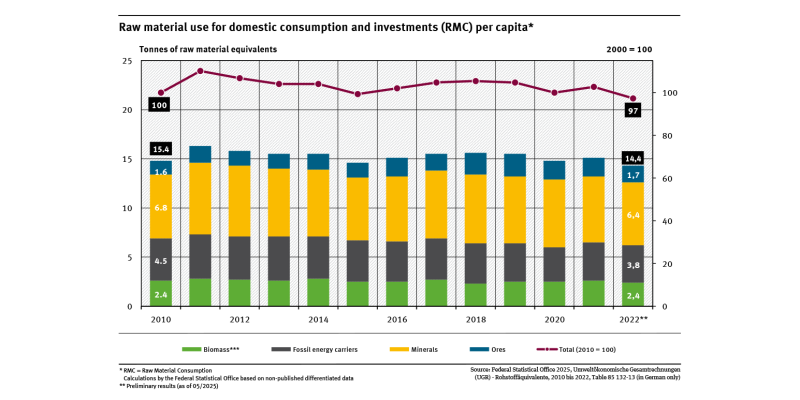Indicator: Raw material footprint
 Click to enlarge
Click to enlargeSource: Federal Statistical Office of Germany Figure as PDF
 Umweltbundesamt
Umweltbundesamt
 Click to enlarge
Click to enlarge
- Primary raw material use per capita, or the raw material footprint, decreased only by 3 % between 2010 and 2022.
- These figures include raw materials which were required for the production of consumed goods at home and abroad.
- German raw material consumption is too high by international comparison and is to be reduced further.
The production of goods and the provision of services requires raw materials. The German economy is strongly integrated internationally. Germany imports and exports large quantities of semi-finished and finished products. The weight of raw materials used for this manufacture is taken into account in the calculation of the raw material equivalents. These include all raw materials used in the production of these goods both at home and abroad. The indicator shown here includes the total weight of all goods used in Germany for home consumption – including the ‘raw material equivalents’. In order to make the issue understandable and comparable, ‘raw material footprint is referred to the number of inhabitants in Germany. The mining or cultivation of these raw materials and their subsequent processing are accompanied by large environmental impacts. If the global per capita raw material consumption were as high as in Germany, this would put a heavy burden on global ecosystems. Germany is therefore responsible for reducing the use of primary raw materials.
Per capita consumption of raw materials fluctuated slightly between 2010 and 2022. After an initial increase of 10 %, it remained slightly above the initial level. In 2022, per capita raw material consumption now stands at 97 % of the initial level marking the lowest value since 2010. There was a noticeable reduction of 0.7 tonnes per capita between 2019 and 2020, which is partly due to the restrictions imposed as part of the Covid-19 pandemic measures. In particular, there was a noticeable decline in investment demand in the economy. In contrast, demand for raw materials for consumption by the state and private non-profit organisations increased by around 10% between 2019 and 2021. This trend can also be seen in the raw material groups: Falling demand for fossil fuels (e.g. in transport) and metal ores (e.g. in mechanical engineering and vehicle construction) was offset by a relatively constant demand for mineral raw materials (e.g. construction activities of the state). From 2021 onwards, demand for fossil fuels rose almost back to pre-coronavirus levels, whereas consumption of mineral raw materials declined significantly. This is mainly due to a 6% drop in demand for mineral raw materials in the construction sector as a result of reduced construction activity in Germany. The recycling of waste is also relevant: This reduces the need for raw materials that need to be extracted from the environment and is counted towards raw material consumption. So far German and European policies have not set a quantitative target for raw material consumption. However, experts and the German Environment Agency believe that consumption of raw materials needs to be reduced considerably. In the National Circular Economy Strategy adopted in 2024, the German government took up this assessment and formulated a significant reduction in primary raw material consumption by 2045 as a guiding principle. A raw material footprint of 6-8 tons is considered an ambitious target value.
The indicator is composed of domestic raw material extraction and imports minus exports. The method was developed in research projects for the German Environment Agency and is described in a research report (in German only). In addition to raw material use for domestic consumption and investment, Germany's raw material footprint also includes stock changes in raw material equivalents. Due to methodological adjustments by the Federal Statistical Office, the time series from 2010 onwards differ from previously published figures. More detailed explanations can be found in the statistical report Statistischen Bericht "Rohstoffäquivalente - Berichtszeitraum 2000-2022" (in German only). To calculate the index values on which this indicator is based, the Federal Statistical Office uses more precise data than those published there.